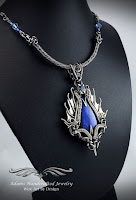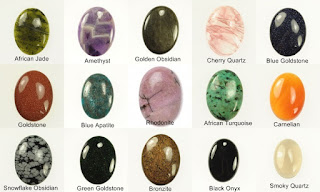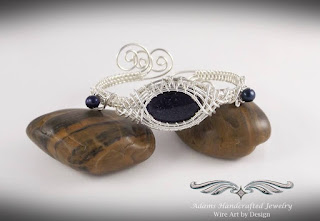Is It Natural or Man-Made? I'm often asked this question concerning the Cabochons and faceted gemstones in my jewelry. Here are a few things to consider.
What makes something natural? Think of the things that come directly from the environment. Air, water, and soil are resources that exist in nature. People cannot make natural resources.

People can change natural resources. Something created by a person that does not occur naturally in the environment is man-made. Let’s see if we can decide what is natural and what is man-made.
Take a walk outside. Breathe in the fresh air and look around. Do you see any trees?
The air is natural and so are the trees. People use the trees to make new things. Trees are cut down to make lumber to build houses. We can also change trees into paper. Paper and lumber are man-made.
When you visit the beach, you can feel the sand between your toes. Nobody makes the sand, it occurs naturally in the environment. Some people use the sand to make glass bottles or jars. A glass bottle or jar is man-made.
Have you ever heard of limestone? It is a type of rock that occurs naturally in the environment. We dig limestone from the Earth and cut it into blocks for constructing buildings. We also use limestone to make toothpaste. Limestone blocks and Toothpaste are man-made.
Clay also comes from nature. It comes from finely ground minerals. People mold clay into plates, pots for plants, and floor tiles. Clay pottery is man-made.
Stones come from nature, lapidaries cut, grind and polish these stones changing them into cabochons or faceted gemstones for jewelry. Using the above rationale, are Cabochons and faceted gemstones man made or natural?
All of this leads to my question, that once you take a stone out of it's natural environment and manipulate it into something that does not occur naturally in the world, such as a cabochon or faceted gemstone, then is it effectively man made? If there is no difference between cutting and grinding which changes the shape, polishing the surface which enhances the color, dying or heating which may change the color or composition, or using acrylic, super glue, water glass or opticon to fill cracks, pits, or vugs in order to stabilize or enhance the appearance aren't you still changing the base natural material into something suited for another purpose... i. e. Jewelry making?
Using this same reasoning, you can dig a small hole and stick your piece of lumber in it, cover it up and pretend it's still a natural tree, but would you be correct? Is it a man made piece of lumber, or will it ever grow roots and branches and leaves and go back to being a tree? Could the same logic be applied to cabochons and faceted gemstones. In my mind, if it is cut by Man and Made into a cabochon, then it is Man-made no matter the base material. Something to ponder, but I will let each of you draw your own conclusions.

People can change natural resources. Something created by a person that does not occur naturally in the environment is man-made. Let’s see if we can decide what is natural and what is man-made.
Take a walk outside. Breathe in the fresh air and look around. Do you see any trees?
The air is natural and so are the trees. People use the trees to make new things. Trees are cut down to make lumber to build houses. We can also change trees into paper. Paper and lumber are man-made.
When you visit the beach, you can feel the sand between your toes. Nobody makes the sand, it occurs naturally in the environment. Some people use the sand to make glass bottles or jars. A glass bottle or jar is man-made.
Have you ever heard of limestone? It is a type of rock that occurs naturally in the environment. We dig limestone from the Earth and cut it into blocks for constructing buildings. We also use limestone to make toothpaste. Limestone blocks and Toothpaste are man-made.
Clay also comes from nature. It comes from finely ground minerals. People mold clay into plates, pots for plants, and floor tiles. Clay pottery is man-made.
Stones come from nature, lapidaries cut, grind and polish these stones changing them into cabochons or faceted gemstones for jewelry. Using the above rationale, are Cabochons and faceted gemstones man made or natural?
All of this leads to my question, that once you take a stone out of it's natural environment and manipulate it into something that does not occur naturally in the world, such as a cabochon or faceted gemstone, then is it effectively man made? If there is no difference between cutting and grinding which changes the shape, polishing the surface which enhances the color, dying or heating which may change the color or composition, or using acrylic, super glue, water glass or opticon to fill cracks, pits, or vugs in order to stabilize or enhance the appearance aren't you still changing the base natural material into something suited for another purpose... i. e. Jewelry making?
Using this same reasoning, you can dig a small hole and stick your piece of lumber in it, cover it up and pretend it's still a natural tree, but would you be correct? Is it a man made piece of lumber, or will it ever grow roots and branches and leaves and go back to being a tree? Could the same logic be applied to cabochons and faceted gemstones. In my mind, if it is cut by Man and Made into a cabochon, then it is Man-made no matter the base material. Something to ponder, but I will let each of you draw your own conclusions.



























